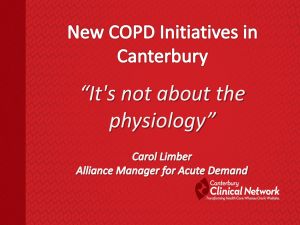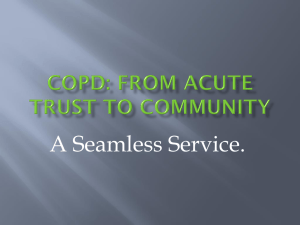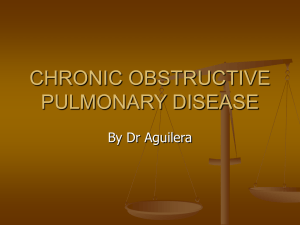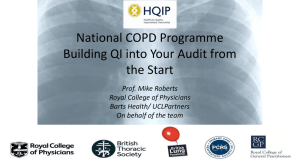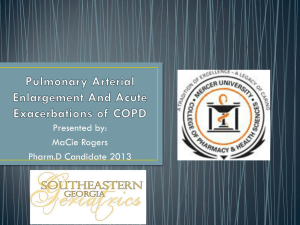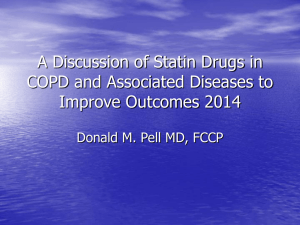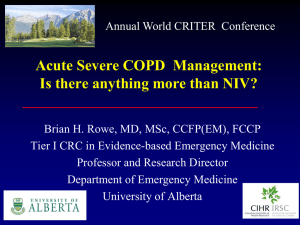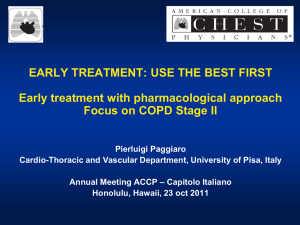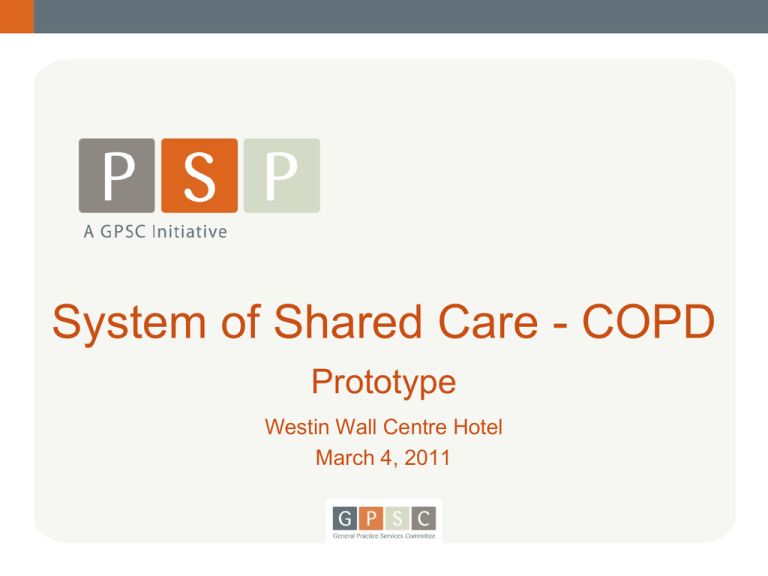
System of Shared Care - COPD
Prototype
Westin Wall Centre Hotel
March 4, 2011
1
Session Opening
Dr. Gordon Hoag
2
Welcome!
• Agenda
• Introductions
• Vision of shared system of care for COPD
3
A new approach
• PSP never before worked in a fully shared care environment
• A System of Shared Care for Patients with COPD will first
require a prototyping approach, potentially followed by the
traditional Train-the-Trainer model
• Prototyping involves all participants
GPs, MOAs, Respirologists, RTs, PSP coordinators, and
patients
to co-develop the content for this shared care module
• Trialling and developing new relationships in local communities
• Coordinating with Partners in Care initiative
• Building on experience with Community Integration from the
End-of-Life module
4
“The best way to predict your future is
to create it”
Abraham Lincoln
“The best way to predict your future is
to invent it”
Steve Jobs
5
Prototyping
• Prototyping is the process of building a model of
a system
• Prototyping is an iterative process
6
Prototyping process
Ideas have
broad
evidence of
achieving
aim
Ideas for
change
PSP
Prototype
Ideas with
some
evidence of
achieving
aim
LS2
AP
LS1
Expert
Meeting
Ideas
perceived
as new
Develop
Ideas
Test Ideas
Strategy for change
Implement
and Spread
Ideas
7
Some challenges of prototyping
• Rushing to solutions without considering
improvements
• Stakeholders expect the prototype to be the
ultimate system
• People involved in development get too attached
to the prototype
8
Advantages of prototyping
• Requires involvement of those working in, or
using, the system
• Facilitates implementation and spread since the
participants know what to expect
• Allows the people making changes to the system
to see what things might improve the system in
the future
• Shortens the learning curve and accelerates
improvement
• Reduces the costs of change
9
Prototype aim
To create a system of care that improves the
quality of care and experience for patients at
risk for and living with COPD
Prototyping is to start with COPD and can expand to other conditions
10
How will we achieve this aim?
• Identifying patients earlier who have COPD using
a case-finding approach
• Developing relationships and care plans amongst
family physicians, specialists, patients, and
community services
• Implementing more standardized referral and
consult letters, and improving relationships, hand
offs, and communication between GPs and
specialists
• Improving the management of COPD by
putting the GPAC guidelines into practice
11
How will we achieve this aim?
• Earlier identification of patients with COPD
• Supporting patients to quit smoking
• Risk stratification based on level of airflow
obstruction, symptoms, and exacerbation history
– followed by review of prescriptions
• Enhancing patient self-management skills to
manage their condition
• Referring patients to appropriate community
services and resources
• Improving the patient experience with
the system of care
12
How will we know our changes are
improvements?
Outcome measures:
• Reported improvement in COPD patient
experience
13
How will we know our changes are
improvements?
Process measures:
• % of patients on register having confirmed diagnostic
spirometry
• % of registry patients with an exacerbation plan
• % of registry patients with a coordinated care plan
amongst GPs, specialists, and/or community resources
• % of smokers on patient registry offered smoking
cessation support
• % of registry patients reporting an Emergency
Department visit for COPD since their last appointment
• % of registry patients reporting a hospital
admission for COPD since their last
appointment
14
How will we know our changes are
improvements?
Balance measure:
• 3rd next available for diagnostic spirometry in the
labs
15
B.C.’s Expanded Chronic Care Model
COMMUNITY
HEALTH CARE ORGANIZATION
(VCHS)
Implementing
policy to
enhance
health
Creating
Supportive
Environments
Self
Management
Delivery
System
Design
Strengthening
Community
Action
Activated
Community
Informed
activated
client
Clinical
Informatio
n Systems
Decision
Support
Productive
Interactions &
Relationships
Population Health Outcomes
Clinical/Functional Outcomes
Prepared
proactive
practice
team
Prepared
Proactive
Community
Partners
16
Target population
A. For Case-Finding Simple Spirometry
1. New Pts: According to BC Guidelines and CTS:
– Smokers /Ex smokers older then 40
– Persons with persistent cough or sputum
– Persons with frequent respiratory infections
– Persons with progressive activity related SOB
2. Possible-Dx COPD, no spirometry
B. Population 3-Confirmed Dx of COPD (Spirometry
Positive)-Main focus of this initiative
17
Patient/Family’s Voice
Lois North
18
Prevalence and Burden of COPD
Dr. J. Mark FitzGerald
19
Trends in age-standardized death rates
(Percent change between 1970 and 2002)
20
Trends in death rates
Trends in Age-Standardized Death Rates for the
6 Leading Causes of Death in the United States,1970-2002
Jemal A et al. JAMA 2005:294:1255-9.
21
COPD mortality in Canada, 1950 to 2002
12,000
35
30
10,000
Deaths
Crude Rate
Age Standardized Rate
8,000
20
6,000
Deaths
Rate per 100,000
25
15
4,000
10
2,000
5
0
0
1950 1952 1954 1956 1958 1960 1962 1964 1966 1968 1970 1972 1974 1976 1978 1980 1982 1984 1986 1988 1990 1992 1994 1996 1998 2000 2002
Year
Centre for Chronic Disease Prevention, Public Health Agency of Canada, 2006
(using Statistics Canada data)
22
Statistics (CTS report Feb 2010)
COPD now accounts for the highest rate of hospital admissions
among major chronic illnesses in Canada (CIHI – 2008)
23
Hospital costs in Lower Mainland:
$40 million dollars
24
Estimated number of persons
at risk of COPD in BC 249 250
Thousands of persons
348
ESTIMATES
253
256
259
261
2012
2013
2014
2015
99
249
Persons over Less persons Persons at
40 who smoke diagnosed risk of COPD
in BC (15%*) with COPD
2010 breakdown
2010
2011
Number of persons at risk for COPD**
*BC Stats for population, Summary of smoking rates for BC, Sept 2006-August 2007
** Based on population estimates by year times a 15% smoking rate, less the number of
persons expected to have COPD.
It is assumed for simplicity that all smokers over 40 are at risk for COPD
Source: Actual figures from COPD registry data, Ministry of Health
25
Number of persons with COPD in BC
ESTIMATES
Actual
Projection
76,408
2004
80,268
2005
84,226
2006
87,725
2007
92,198
2008
95,216
2009
98,860
2010
102,504
2011
106,148
2012
109,792
117,080
113,436
2013
2014
2015
Assume relatively linear increase in prevalence will continue to 2014
Source: Actual figures from COPD registry data, Ministry of Health
26
COPD expected incidence in BC to 2015
ESTIMATES
Actual
Projection
10,851 11,018
9,715
10,122
11,398
11,778
12,157
12,537
12,916
13,296
9,763
9,055
2004
2005
2006
2007
2008
2009
2010
2011
2012
2013
2014
2015
Assume linear increase in incidence will continue to 2014
Source: Actual figures from COPD registry data, Ministry of Health
27
COPD is underdiagnosed
Chronic Obstructive Pulmonary Disease Surveillance, United States,
1971–20001
Airflow Limitation, Mild Through Very Severe, Canada, 20052
400
350
Diagnosed with chronic bronchitis or emphysema
Airflow limitation (mild through very severe2)
300
250
200
150
100
50
0
25–44
45–54
55–64
Age (y)
65–74
1. Mannino DM, et al. MMWR. 2002; 51:1-16. 2. O’Donnell DE, et al. Can Respir J. 2008;15
(Suppl A):1A-8A.
75
Undiagnosed potential
Rate per 1,000 of population
450
28
Health-related quality of life in undiagnosed
COPD
Mild COPD
Undiagnosed
Control
35
**
Mean score
30
25
**
**
20
*
15
**
**
*
10
**
5
0
Total
Symptoms
Activity
Impact
SGRQ Dimensions
SGRQ = St George’s Respiratory Questionnaire
Miravitlles M, et al. Thorax. 2009;64:863-868.
*P < 0.01; **P < 0.001
29
System of Shared Care
Dr. Philip White
30
Disclosures
There are no disclosures with regard to this
presentation
Development criteria for all guidelines
• Scope statement
• 6 pages of clinical information (+or-)
• CDM format where applicable which includes flow
sheets and patient information guides as
appendices
• Appendices as required esp. drug info. and
costing
• Rationale
• References
Chronic Obstructive Pulmonary Disease
(COPD) Effective Date: January 1, 2011
Scope
This guideline provides strategies for the improved
diagnosis and management of adults with chronic
bronchitis and emphysema (chronic obstructive
pulmonary disease, COPD).
Diagnostic Code: 496 (chronic airways
obstruction, not elsewhere classified) BRITISH
COLUMBIA MEDICAL ASSOCIATION Guidelines
& Protocols Advisory Committee
COPD Guideline
• Scope:
• Diagnosis: COPD is under-diagnosed. A definitive diagnosis is
made with spirometry.
• Management of COPD
• Smoking Cessation
• Education and self-management
• Pharmacologic management (refer Appendix B)
• Ongoing care
• Acute exacerbations (AECOPD) require more intensive
management.
• Manage co-morbidities
• Indications for specialist referral
• End of life care
Appendices
Appendix A - Patient Care Flow Sheet
Appendix B - Prescription Medication Table for Chronic Obstructive
Pulmonary Disease (COPD)
Appendix C - Medical Indications for Home Oxygen for Stable COPD
Patients
Appendix D - COPD Flare-up Action Plan
Appendix E - Antibiotic Treatment Recommendations for Acute
Exacerbations of COPD (AECOPD)
Associated Documents
The following documents accompany this guideline:
• Patient Guide
• Summary
36
GPAC: Care objectives
Encouraged to:
• identify
• monitor
• recall
• review for goals of care
• consider co-morbidities
Therapeutic goals:
• prevent disease
progression
• alleviate symptoms
• ↑ exercise tolerance and
daily activity
• ↓ exacerbations
• ↑ health status
• ↓ reduce mortality
37
Patient care flow
sheet
38
GPAC: Management of COPD
•
•
•
•
Lifestyle management (smoking cessation)
Education and self-management
Pharmacologic management
Ongoing care:
Immunization for influenza and
pneumococcus
Oxygen therapy (medical
indications)
GPAC: Management of COPD (continued)
• Acute exacerbations require more intensive
management
• Manage co-morbidities
• Specialist referral
• End of life care
Type of info. provided on Med. charts
Generic Name Trade Name
(formulation)
[strengths]
Standard Rx for Adults
(max. dose per day)
Approximate Cost*
PharmaCare Coverage
• Most guidelines are downloadable onto
PDAs, Blackberries etc. from the UBC
website
Appendix C: Medical Indications for Home Oxygen for Stable COPD Patients
Note: This is an example from the Fraser Health Authority. Consult your local health
authority for local criteria.
Objectives of Home Oxygen Therapy
• Oxygen therapy should aim for an arterial PaO2 of 60 to 65 mm Hg (oxygen saturation
greater than 90 per cent), at rest, and/or on exertion, and/or for nocturnal use.
• Reduction in the complications of chronic hypoxia.
• Increased activities of daily living.
At rest (on room air): Pa O2 ≤ 55 mmHg; OR SpO2 always ≤ 88% sustained continuously
for 6 (six) minutes; OR PaO2 = 56-60 mmHg with evidence of Cor Pulmonale, Pulmonary
Hypertension, or Heart Failure, or polycythemia.
On exertion (6 minute walk): SpO2 ≤ 87% (on room air) sustained continuously for 1 (one)
minute during a 6 (six) minute flat surface walk.
Nocturnal Use: Nocturnal oximetry (minimum 4 hour study) with SpO2 ≤ 89% for > 20% of
the night OR SpO2 ≤ 89% for > 10% of the night with evidence of Cor Pulmonale,
Pulmonary Hypertension, or Heart Failure, or polycythemia.
Palliative and pediatric clients must still qualify with the above criteria for subsidy.
Infant clients SpO2 always < 93% sustained continuously for 6 (six) minutes OR as
assessed by a pediatric specialist.
Provide oxygen litre flow required maintaining SpO2 ≥ 90% at rest, and/or on
exertion, and/or for nocturnal use.
Exacerbation
Plan
43
Systemic corticosteroids for acute
exacerbations of COPD
• 11 studies (1081 pts.)
• Treatment failure within 30 days with OCS:OR
0.50 (0.36-0.69). NNTT: 10 pts.
• LOS: -1.22 days (-2.26—0.18).
• Improved FEV1 and less dyspnoea.
• No mortality effect.
• Adverse event: OR 2.33 (4-9).
• Hyperglycemia: OR 4.95 (2.47-9.91)
Cochrane 2009
Meta-analysis of Efficacy: Systemic
corticosteroids and risk for treatment failureFailure
Favors Steroid
Favors Placebo
Bullard et al, 1996
Thompson et al, 1996
Davies et al, 1999
Niewoehner et al, 1999
Maltais et al, 2002
Aaron et al, 2003
Pooled summary
(RR, 0.54; 95% CI, 0.41-0.71)
0.1
0.2
0.5
1
2
5
10
Relative Risk (95% Confidence Interval)
Reproduced with permission of Chest, from “Contemporary Management of Acute Exacerbations of COPD”,
Quon BS et al, Vol 133, Copyright © 2008; permission conveyed through Copyright Clearance Center, Inc.
45
45
Antibiotics for exacerbations of chronic
obstructive pulmonary disease-1
• Eleven studies included in the review
• Antibiotic therapy regardless of antibiotic
choice significantly reduced:
- mortality (RR 0.23; 95% CI 0.10 to 0.52
with NNT of 8; 95% CI 6 to 17)
Antibiotics for exacerbations of chronic
obstructive pulmonary disease-2
• Treatment failure (RR 0.47; 95% CI 0.36 to
0.62 with NNT of 3; 95% CI 3 to 5) and,
sputum purulence (RR 0.56; 95% CI 0.41
to 0.77 with NNT of 8; 95% CI 6 to 17).
• There was a small increase in risk of
diarrhea with antibiotics (RR 2.86; 95% CI
1.06 to 7.76).
Meta-analysis of Efficacy: Antibiotic
therapy and risk for treatment failure
Study
Alonso 1992
Antibiotic
Group
n/N
Placebo
Group
n/N
Relative Risk (Forced)
95% CI
Weight
(%)
Relative Risk
(Forced)
95% CI
2/29
6/29
3.5
0.33 [0.07, 1.52]
19/57
28/59
16.2
0.70 [0.45, 1.11]
6/29
19/29
11.2
0.32 [0.15, 0.68]
49/132
49/136
28.4
1.03 [0.75, 1.41]
Pines 1968
6/15
15/15
8.8
0.40 [0.22, 0.74]
Pines 1972
31/89
53/86
31.8
0.57 [0.41, 0.79]
351
354
100.0
0.67 [0.56, 0.80]
Anthonisen 1987
Elmes 1965a
Jorgenson 1992
Total (95% CI)
Total events: 113 (Antibiotic Group), 170 (Placebo Group)
Test for heterogeneity dri-square = 15.46 df = 5 p = 0.009 F = 67.7%
Test for overall effect z=4.27 p=0.00002
0.1 0.2
0.5
Favors Antibiotic
1
2
5
10
Favors Placebo
Ram FS, et al. Cochrane Database Syst Rev. 2006;CD004403. Permission requested.
48
Appendix E: Antibiotic Treatment Recommendations for Acute Exacerbations of
COPD (AECOPD)
Antibiotic Treatment Recommendations for Acute COPD Exacerbations
Category
Symptoms & Risk Factors
Antimicrobial treatment
Simple COPD
No risk factors
Increased dyspnea, increased cough and sputum, sputum purulence
• FEV1 ≥ 50% of predicted
• < 4 exacerbations/year
Complicated COPD
Have 1 or more risk factors for treatment failure and/or more virulent or resistant
pathogens
Increased dyspnea, increased
cough and sputum, sputum purulence plus at least 1 of the following:
• FEV1 < 50% of predicted
• ≥ 4 exacerbations/year
• ischemic heart disease
• use of home oxygen
• chronic oral steroid use
• antibiotic use in the past 3 months
References: CTS COPD Recommendations - highlights for primary care. Can
Respir J 2008;15(Suppl A):1A-8A.
49
A Guide for Patients
Effective Date: December 30, 2009
What is Chronic Obstructive Pulmonary Disease (COPD)?
Chronic obstructive pulmonary disease includes chronic bronchitis and emphysema.
Smoking is the most important cause of these diseases, although non-smokers can also
get COPD. If you smoke, quitting will reduce the severity of the disease and help
you improve the quality of life over a much longer time.
Chronic bronchitis and emphysema
In chronic bronchitis, inflammation occurring in the bronchial tubes may cause
narrowing, which makes breathing difficult. A chronic cough that brings up sputum and
mucus is present.
In emphysema, lung tissue and the small air sacs (alveoli) at the end of the airways
become damaged and air becomes trapped in the lungs leading to shortness of breath.
COPD exacerbations
An exacerbation is a worsening of the condition that includes the following signs:
• rapid increase in cough
• sputum and mucus production (especially if yellow or green)
• increased shortness of breath
• blue lips or fingers
Exacerbations can be serious and life-threatening. Prompt and effective treatment can
help most people recover to the level of breathing before the
exacerbation.
Diagnosis
50
Stepped approach to care
51
Indications for specialist referral
• The diagnosis is uncertain.
• A young patient with COPD and limited smoking history or those with
severe symptoms and disability which is disproportionate to their lung
function decline.
• There are signs and symptoms of hypoxemic or hypercarbic respiratory
failure.
• There are severe or recurrent exacerbations and treatment failure.
• The patient has severe COPD and disability requiring more intensive
interventions including surgical therapies.
• More intensive co-morbidity assessment and management
is required.
• Difficulty in assessing home oxygen or sleep disorders.
52
Brainstorming about roles in
COPD care
Dr. Gordon Hoag
53
Team approach
• Who is on your team?
• What role do they play?
• What role could they play?
• What changes could be tested in your
community?
54
At your table
• Discuss and brainstorm answers to the questions
• Pick someone to report
• Be prepared to share with the larger group
55
Share
•
•
•
•
•
Where is your team from?
Who is on your team?
What role do they play?
What role could they play?
What changes could be tested in your
community?
56
Action plan: Clarify roles in COPD care
• Identify your local COPD care team using the
stepped care approach as a guideline to identify
care team roles
57
Spirometry
Dr. Jeremy Road
58
What is Spirometry?
Spirometry is a method of assessing lung
function by measuring the volume of air that
the patient can expel from the lungs after a
maximal inspiration.
Only one way of interpreting COPD disease
severity.
Other measures e.g. MRC dyspnea scale
59
Purpose
• Case finding for early identification and
intervention
• Reduce negative testing at the labs
60
Why perform Spirometry?
• Confirm the presence of airway obstruction
Confirm an FEV1/FVC ratio<0.7 after bronchodilator
• Provide an index of disease severity
• Help differentiate asthma from COPD
• Detect COPD in subjects exposed to risk factors, tobacco
smoke, independent of the presence of respiratory
symptoms
• Enable monitoring of disease progression
• Help assess response to therapy
• Aid in predicting prognosis and long term survival
• Exclude COPD and prevent inappropriate
treatment if spirometry is normal
61
What does Spirometry measure?
• Spirometry tells your doctor if you are breathing normally
• Through different breathing measurements, including:
Forced Vital Capacity(FVC): the largest amount of air
that can be breathe out after you take your biggest
breath in.
Forced Expiratory Volume(FEV1): the amount of air
you can force out of your lungs in one second
62
What can Spirometry provide in COPD
management?
• The diagnosis of COPD is based on the results of
spirometry
• COPD cannot easily be diagnosed by physical
examination of Chest X-ray findings.
• FEV1/FVC ratio of < 0.7 post bronchodilator is
diagnostic in a current or past smoker
63
The COPD6
• If you have a normal result has the potential to
rule out COPD
• May have some false positives due to 6 second
exhalation time reducing the denominator ie
FEV1/FEV6.
64
• If FEV1/FEV6 is low ,<0.7 ,then refer to
accredited lab for definitive diagnosis
• Walk in spirometry clinics
65
COPD-6
FEV6 & Ratios
(And multi-patient use. Exceeds ATS/ERS guidelines)
Use
Detach flow
head
for cleaning
(enter Age, Height; Sex and blow for 6 seconds
Press Enter to view best)
Includes predicted value sets
Built-in quality of blow indicator
Large easy to read display
Branding area
Displays FEV1 and % predicted
Displays FEV6 and % predicted
Lung Age indicator
Displays FEV1/FEV6 and % predicted
Provides GOLD COPD classification
(Class I; II; III; IV)
Obstructive Index and
displays degree of obstruction
66
COPD-6 (continued)
Built-in quality of blow indicator
Slow Start Warning: Vext >5% or 150mL of FEV6
Abrupt End: Change of volume is > 25mL in the last sec
No coughing: 50% drop & recovery in flow in the 1st sec
If Blow <1 sec FEV1 = 0.00
Result out of Range FEV6 (0-8L)
Obstructive Index (Measured FEV1/Pred FEV1) &
COPD Stage I - IV (with ratio FEV1/FEV6 > 70%)
Low battery indicator
Green ≥ 80%+ratio > 0.70
Green ≥ 80%
Yellow = 50 - 80%
Orange = 30 - 49%
Red
< 30%
All boundaries can be reset
= Not COPD
= STAGE I
= STAGE II
= STAGE III
= STAGE IV
67
COPD-6 (continued)
1. Turn on
2. Scroll up/down
3. Press Enter
4.
5.
6.
7.
Scroll up/down
Press Enter
Scroll up/down
Press Enter
(Age Symbol and 50 appears on
screen)
To adjust age (if the buttons are kept
depressed, the values will scroll faster)
(Height Symbol and 60 appears on
screen)
To adjust height in inches
(Male Symbol appears on screen)
For Female symbol
(Population Group Symbol appears on
screen)
68
Entering subject data continued
8. Scroll up/down to select:
•
•
•
•
C - Caucasian NHANES III
AA - African-American NHANES III
HA - Mexican-American NHANES III
Note: use C for all other races
9. Press Enter
69
Copd-6 is now ready for blow
•
Place a SafeTway Mouthpiece into the
Copd-6
•
Hold your head up, breathe in as deeply
as possible, place the mouthpiece in
your mouth, biting it lightly while sealing
your lips firmly around it.
•
Blow out as HARD and FAST as you
can for a full 6 seconds.
•
Repeat 2 more times when the blow
icon appears.
•
Hold down the enter key to bring up the
last session results
70
Results of blow
•Blow is classified as Green, Yellow, or Red
•Obstructive Index (Measured FEV1/Pred FEV1) & COPD Stage I - IV (with
ratio FEV1/FEV6 > 70%)
•Green ≥ 80%+ratio > 0.70
= Not COPD
Green ≥ 80%
= STAGE I
Yellow = 50 - 80%
= STAGE II
Orange = 30 - 49%
= STAGE III
Red
< 30%
= STAGE IV
71
Indication of bad blow
•
•
The blow icon with an
exclamation point indicates a
bad blow.
Possible reasons are coughing,
slow start, blow less than 3
seconds in duration, abrupt
stop, or blocking the back of
copd-6 unit with hand.
72
Test results after three blows
Press Enter to display the best of the
session
Press enter to display the best FEV1
and percent predicted of all blows
Press the down arrow to see Lung
Age
Press the down arrow again to see
FEV1/FEV6 Ratio & percent
predicted
Press the down arrow again to see
FEV6 & percent predicted
73
The Copd-6 USB version’s printed report
74
Training
http://www.youtube.com/watch?v=syXXEgZSTOQ
75
Fee
Proposed $10 fee subject to approval
76
Table demo - Happy case-finding!
77
Break
78
Referral Process
Clay Barber, Helen Roberts
79
Communication issues. Solutions?
•
•
Construct well-defined questions at time of referral
Demand clearer structured consult letters from
consultants
Diagnoses/problems summarized
Recommendations clearly laid out
Faster turnaround time for consult letters
• Implement a mechanism for TWO WAY feedback and
sync of information
• EMRs: may help many issues • push/pull info, sync meds
80
Partners in Care
Compacts
81
Approach
• Planning the process (PLAN)
o Outcome for the referral process
o Steps for the current process
• What is working
• What is not working
• What ideas do we have for improvement
o Determine content/template for a referral
• Implementation of the process (DO)
o Decide on when and where to test
• Evaluating the process (STUDY)
o Determine how to evaluate the PDSA cycle
• Revising the process (ACT)
o Repeat cycles as necessary
82
Telephone consult
• Structured
RACE (St. Paul’s)
RACE (Kelowna General Hospital)
Unstructured, e.g.
10001 – Urgent Specialist telephone advice (< 2
hours)
10021 – Urgent GP with Specialty Training Telephone
advice (< 2 hours)
83
Partners in Care and prototyping in your
community
Partners in Care (PiC)
Potential next steps
Naïve
Prototype with a focus on
COPD and then expand to
other specialties and more
diseases
In progress/complete
Collaborate with PiC work
84
Community Healthcare and Resource
Directory (CHARD) - referral process support
CHARD: secure, web-based
directory of specialists and
services to improve referrals
Access relevant and up-to-date
details on available resources to
ensure appropriate and complete
referrals to the right care provider
Receiving physicians can clearly
state their referral criteria and
processes up-front
A centralized location to post
standardized referral forms,
procedures, or patient instructions
Improve MOA efficiency in locating
resources and preparing referrals
“
Having CHARD at my fingertips
helps enrich and broaden the
spectrum of recommendations I
can give GPs when I do
Collaborative Care: higher quality
resources closer to home for
patients; more informed and
tailored choices of resources for
patients; and more patient
engagement in selection of
choices.
Dr. Rivian Weinerman
Psychiatrist, Victoria
”
85
Video
• Consult discussion
86
Table discussion
87
Report back
88
IM/IT Enablers
Towards the Promised Land
Dr. Jeff Harries
89
Data sharing standards
• EMRs should have the capability to identify
individuals based on specific data elements
• Implement data standards:
Reliably distinguish document type
o e.g. referral letter, consultation report, discharge summary
Identify important elements of document types and the
EMR that need to be coded
90
Secure data sharing
• Develop ways to support the secure
communication of patient related information:
Between providers
Between Health Authorities and providers
91
Electronic referral process
• Access to Clinically relevant information is currently not as good as it
could be.
• Our system of care has developed over time in a fragmented manner for
a number of reasons; some good reasons, some bad reasons.
• Primary Care Clinics often have the most complete information available
because they receive information from a variety of sources (Discharges,
OR Reports, Consults, Home Care, Mental Health, Old records from
previous MD, etc).
• How can information be pushed out when needed?
• Three choices:
Paper – Costly to send, Costly to receive, Costly to use, Slow
Electronic – Cheap to send, Costly to receive, Costly to use, Fast
Electronic but Smart – The Promised Land
(Cheap to send/receive/use, and Fast)
92
Smart eReferral Process
• The Vendor our Community of Practice in the
South Okanagan chose developed a Smart
way of sending information between MDs and
other Clinics. We have been using it for over a
year and it is terrific.
• Doing this same Process between Vendors is
much more complicated and difficult to
achieve, but it is technically possible.
• The following is a demo of an eReferral.
93
Patient Journey Mapping
Margie Wiebe
94
Mapping the Patient
Journey
Context
Quesnel’s Patient Journey Mapping
Story
Video Clip
Patient Journey Mapping objectives
Participants will learn:
Why patient journey mapping is a useful tool for
system redesign
What patient journey mapping is
Who should be on the team & how to prepare them
How to conduct a patient journey mapping, analyze
the map and use it to guide redesign
According to NHS
• 30%-70% of the work in
a patient journey doesn’t
add any value for the
patient
• 80% of health care
problems are system not
people based
Why-Patient Journey Mapping
“ [Patient journey] mapping is a really simple
exercise. It is one of the most powerful ways for
multi-disciplinary teams to understand the real
problems from the patient’s perspective, and to
identify opportunities for improvement. After all,
the only person who experiences the whole
journey is the patient. [Patient journey] mapping
helps us appreciate how this feels and a team can
then make decisions based on fact and
understanding rather than their perceptions of
how the service works” NHS (2005, p.11)
Patient mapping
• It provides a highly visual tool:
Useful to plan high impact improvements in system
redesign
Provides baseline for improvement projects
• It helps all involved to understand how
complicated the system can be for patients
How many bottlenecks, time delays, hand offs and
duplications there are
How many visits they make to the doctor and other
providers
How many times they wait unnecessarily
This is life in a system driven model
“According to the computer, the waiting room is now empty”
In healthcare our roles limit us to seeing
only one small part of the whole patient
process
Patient Journey Mapping
enhances transformational change
• It creates “Head
Shift” thinking
• You see with new
eyes
TRANSFORMATIONAL CHANGE
…the combination of both external
situational change and internal
psychological change
WHAT is mapping?
It is an important method that creates
understanding of a current process or system. It
is a diagnostic strategy for improvement projects
that are focused on improving a process or
system
Langley G. J., Moen R.D., Nolan K.M., et al (2009), The Improvement Guide.
P.410
A process:
• Is a sequence of events to accomplish a work
• Is a series of connected steps or actions to
achieve an outcome
• Is linked to other processes
• Has a defined group of users
• Has a starting & end point (scope)
• Has rules about standards /quality throughout
process

